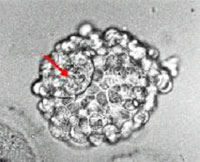Seven In Ten Members Of The Public Support The Use Of Embryos For Medical Research
Around 70% of the British public support the use of human embryos for medical research to find treatments for serious diseases and for fertility research. Over half of adults feel that the use of human embryos for medical research is only acceptable to find treatments for serious diseases and for fertility research, but not for most other types of research. Further, one in six feel the use of human embryos is always acceptable for all types of medical research.
Technical details
- The MORI poll was commissioned jointly by a coalition of several public sector and charitable organisations involved in medical research including the Alzheimer's Society; Association of Medical Research Charities; Biotechnology and Biological Sciences Research Council; British Heart Foundation; Cancer Research UK; Diabetes UK; ESRC; Medical Research Council; Parkinson's Disease Society; Royal Society and The Wellcome Trust.
- MORI interviewed a representative quota sample of 2,001 respondents aged 15+ face-to-face, in-home, throughout GB across 201 sampling points. 957 were asked version 1 and 1,044 were asked version 2 of the questions (as below) between 20-25 February 2003. The questions asked were identical, but for version 1 the respondents were shown additional information, including a photograph of an embryo. Data have been weighted to the national profile.
- Stem cells are cells that can replicate themselves and generate more specialised cell types as they multiply. They occur throughout all stages of human development but their abundance declines with age. In the early human embryo stem cells are found and they form the building blocks of humans with the ability to develop into virtually every other cell type in the body. Very early embryos have plenty of these special cells (described as pluripotent) that have not yet differentiated into more specialised types like heart, brain and nerve cells. These cells first appear some four to five days after fertilisation and they are the 'parents' of all the cells of the adult body. Stem cells can also be found in adults, of course, where they provide ongoing maintenance and repair of the body. Adult stem cells are said to be partially differentiated -- that is, they have made part of the journey towards becoming a particular cell type.
Survey
Version 1 additional information
Sometimes embryos left over from infertility treatment are donated by women and their partners, for medical research. This photograph (Picture A) shows a cluster of cells which is a human embryo, up to 14 days after conception. Picture B shows its actual size.
Picture A
 |
Picture B
 |
| Human Embryo | Actual Size |
Version 1 + 2 results
Q1. Current law allows the use of human embryos up to 14 days after conception to find treatments for serious diseases and for fertility research, but the law does not permit the use of human embryos for most other types of research. On this card is a list of options. Which, if any, most closely describes your view about the use of human embryos in medical research?
| 160 | Version 1 (957) | Version 2 (1,044) |
|---|---|---|
| 160 | % | % |
| The use of human embryos is always acceptable for all types of medical research | 17 | 15 |
| The use of human embryos for medical research is only acceptable to find treatments for serious diseases and for fertility research, but not for most other types of research | 56 | 55 |
| The use of human embryos for medical research is never acceptable | 17 | 20 |



